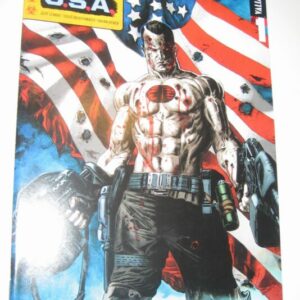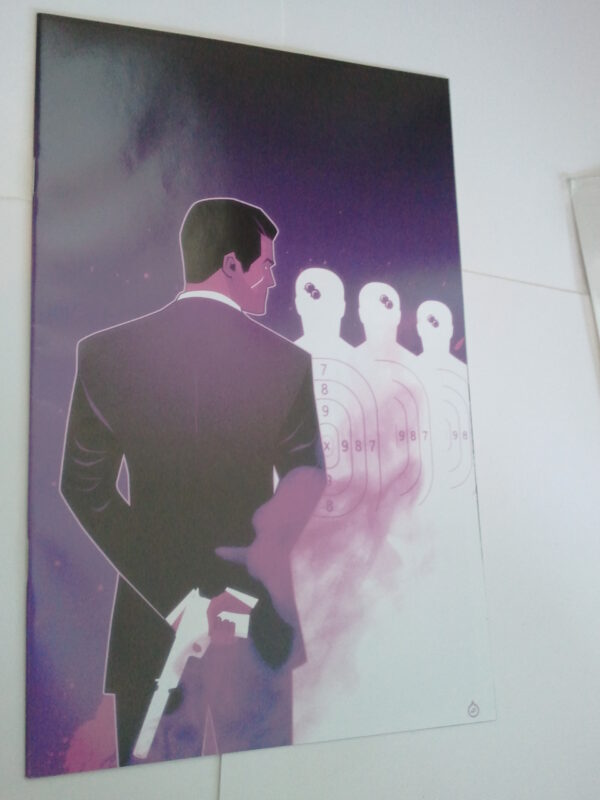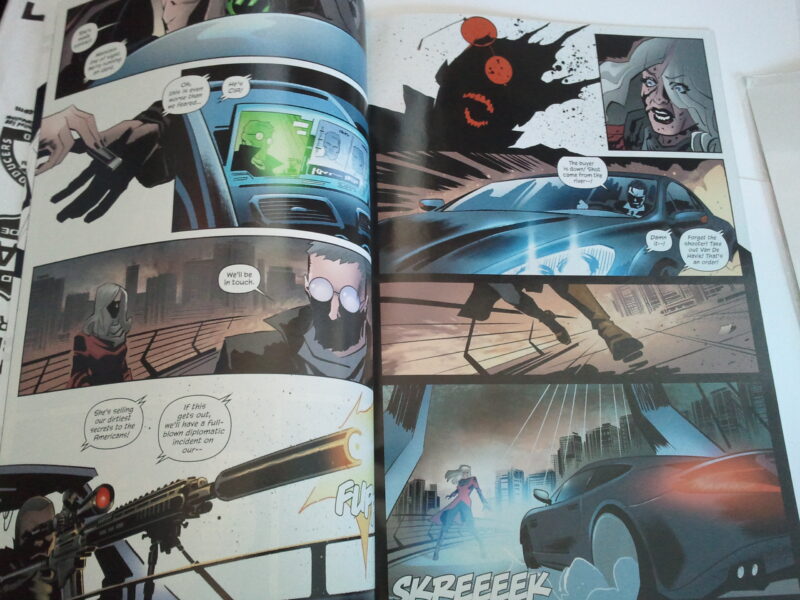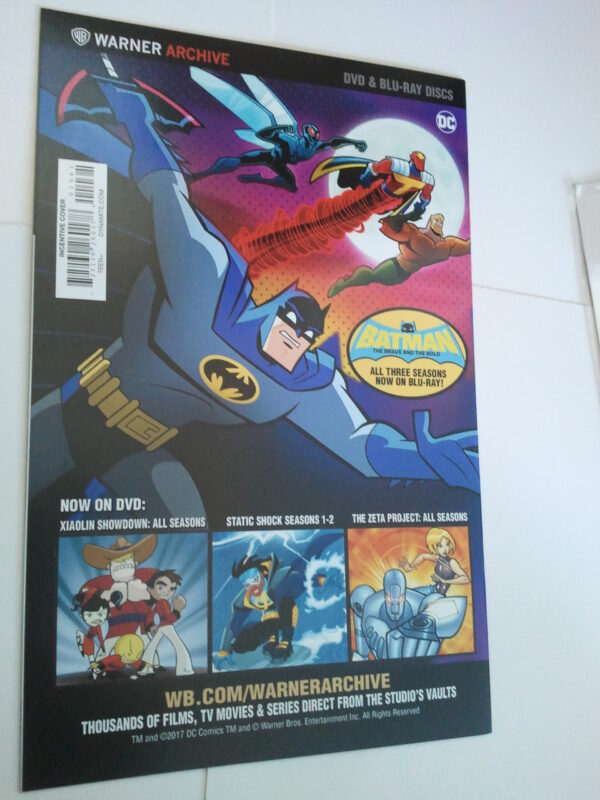James Bond Kill Chain # 1 NM Doe 1:30 Virgin Incentive Cvr Dynamite Andy Diggle
$274.99
Description
James Bond Kill Chain (2017 Dynamite) #1F
Published Jul 2017 by Dynamite Entertainment
Limited 1 for 30 Retailer Incentive Variant Cover
Written by Andy Diggle
Art by Luca Casalanguida
Cover by Juan Doe
32 pages, full color
When a counterespionage operation in Rotterdam goes catastrophically wrong, James Bond finds himself in the crosshairs of a plot to smash NATO. Someone is assassinating allied agents, and 007 is the next target in the kill chain. Having kept the peace for decades, the old alliance is collapsing, pitting MI6 against its former ally – the CIA! Dynamite Entertainment proudly presents the return of writer Andy Diggle (James Bond: Hammerhead, The Losers, Green Arrow: Year One) and artist Luca Casalanguida (James Bond: Hammerhead) as they plot the return of James Bond’s oldest and deadliest foe: SMERSH!
Kill Chain is the newest, of several, James Bond miniseries released by Dynamite over the last few years. The creative team of Diggle & Casalanguida return, after an arc by Gillen & Fuso, to follow up their Hammerhead storyline.
The book starts on a Russian tundra with a dour man speaking in parables. We’re not told this is the “big bad”, but the ominous threat is felt through the art and dialogue.
We catch up with Bond, using his charms to seduce a female agent, Ryka Van De Havik (I kind of love that name). It all seems very by the books, until we find out that she isn’t just another notch on his belt. Like any good spy story, no-one can be trusted. What people are capable of isn’t apparent until you feel their knife in your back. Even as we see that nothing is as it appears, the story is still easy to navigate, and stays intense throughout. Without ruining anything, the issue also leaves Bond contemplating his own actions, a slower moment we don’t often see from the iconic character.
Casalanguida’s art compliments both the Bond aesthetic, as well as Diggle’s gritty writing. He employs a traditional cartooning style like Will Eisner or Darwyn Cooke, with shades of Tim Sale’s darker, rigid figure work. The action is chaotic, but Luca never loses the flow of movement from panel to panel. The female lead is properly seductive, and though Bond doesn’t mirror any of his Hollywood counterparts, you always know it’s him. It’s worth mentioning that the colors were dead on, as well. Drab, muted tones make the blasts of gunfire and explosions pop.
This issue had all the Bond tropes we’ve come to expect, but handles them incredibly well. It also manages to subvert some of those expectations, showing that even Agent 007 is human. The art is spot on and delivers on every front.
James Bond will return…in ‘Kill Chain’: Writer Andy Diggle on his second 007 miniseries
Writer Andy Diggle begins his second James Bond miniseries with Dynamite next week in “Kill Chain.” He describes his interpretation of Bond as a mix of class and brutality and “Kill Chain” as classic espionage in the style of “From Russia With Love.”
Since acquiring the rights to James Bond, comic book publisher Dynamite Entertainment has been busy pushing a wide range of books out its doors, from a top-flight ongoing series to one-shot specials to interesting projects that are still on the way.
British writer Andy Diggle has had his own part of the line since last year with his “James Bond: Hammerhead” miniseries. With his newest contribution to Dynamite’s Bond beginning next week with the deliciously titled “James Bond: Kill Chain,” I talked via e-mail with Diggle on his first Bond book, how he sees the titular spy and what readers can expect in the new miniseries.
When you signed on with Dynamite, were you apprehensive at all about writing Bond?
Absolutely. In fact, I was initially reluctant to accept their invitation to write James Bond, despite it being a dream project, because of my heavy workload at the time. I was worried that I wouldn’t be able to do the character justice if I spread myself too thin. Fortunately, Dynamite were happy to wait for me to clear my schedule, for which I’m grateful. James Bond demands your full attention. If you get him wrong, the fans will know.
What have you learned over the course of “Hammerhead” and now “Kill Chain” about the process of writing the character?
For one thing, I’ve learned that I never have enough pages! I love writing dialogue-driven character scenes as much as I love writing bravura action set-pieces, and both take up a lot of visual real estate on the comic page. Bond demands both. “Hammerhead” and “Kill Chain” easily could have filled twice as many pages. But I like to write stories with pace, urgency, narrative momentum; distilling it down makes the story more potent. I call it the “shot-glass of rocket fuel.” When you only have 20 pages per issue, you want to give the reader as much bang for their buck as possible.
Who is your Bond? What has shaped your take on him?
I can’t help but hear Sean Connery’s line delivery in my head, but the Bond of Ian Fleming’s original novels is my primary source of inspiration. That’s why the series is titled IAN FLEMING’S James Bond. I wanted the original character, updated to the present day but unencumbered by the now obligatory, fetishized, product-placed trappings of the movies — the Walther PPK, the Aston Martin, the vodka martinis.
Fleming’s Bond is often described as cold, but the novels do offer a glimpse of his inner life — his sense of duty, his moral courage, his obstinate resilience. Fleming wrote those first books in the 1950s, when Britain was still recovering from the hardships of World War II and rationing was still in effect. Bond’s stoicism — his ability to endure torture, deprivation and hardship without complaint or self-pity — must have been hugely reassuring to postwar Britain’s sense of itself. I’m thinking here of the notorious torture scene in “Casino Royale”; Bond being dragged across the coral reef in “Live And Let Die”; his exhaust-vent ordeal in “Moonraker.” Bond endures. And of course those descriptions of exotic locales and fine meals, unattainable to most of the population at the time, offered a much-needed sense of escapism to those for whom escape was impossible.
Ultimately Bond has a foot in each of two worlds: suave and brutality. He’s able to step with ease from the world of diplomatic savoir faire to the cut-throat savagery of war. Whatever I do with Bond, it will always have a mixture of both.
“Hammerhead” is about the British Empire and a pretty pointed response to the Trump/neo-nationalist phenomenon. When did you first start to think about the story, and how did it evolve?
It wasn’t so much about Trump as it was about the rise of a certain ultra-nationalistic, rose-tinted nostalgia and xenophobia that has been bubbling up in Britain for some time, and which found its ultimate expression in the catastrophic decision to leave the European Union. That, combined with Britain’s troubling legacy of arms sales to despotic regimes like Saudi Arabia. We know Bond will risk his life for Britain, but what values does Britain represent? What is Bond fighting for? As ever, the answer lies in the original novels. Fleming’s Bond lied about his age so he could enlist to fight the Nazis in Europe. That says it all.
What did you enjoy most about working on “Hammerhead”? What were some of the challenges?
I’ve always enjoyed writing smart, ruthless villains, and Bond stories have always set the standard in that regard. With “Hammerhead”‘s villain “Kraken” I wanted someone with huge resources and an audacious, high-stakes plan that isn’t immediately apparent, but which should hopefully seem obvious in hindsight. And then I send Bond in to mess up that well-laid plan. Fleming described Bond as a “blunt instrument;” I like to think of him as a spanner in the works.
The hardest thing to pull off is putting Bond into desperate, life-threatening situations that he couldn’t possibly survive… and then having him prevail in a way that feels plausible. We live in a post-Austin Powers world now; you can’t just throw Bond into “an easily escapable situation involving an overly elaborate and exotic death” and then send the guards home. My inner Scott Evil is always asking, “Why don’t you just shoot him in the head?”
There’s a scene in the new series where Bond is handcuffed to a table-top and someone’s about to cut his throat. It took me a while to figure out how he was going to get out of that one. The villains can’t be idiots. You have to earn it.
The last panel in “Hammerhead” was pretty striking. Is that how you always wanted the story to end, or did you come to that over time?
It actually came to me as I was writing the final issue. I wanted to end on a slightly ambivalent note; has Bond won the battle but lost the war? He has great respect for M, but little for the politicians he answers to. Hence the Union Jack and the Houses of Parliament in the background. It comes to back to the question — what does Britain stand for?
What would you tell someone who was thinking about picking up the trade?
That it’s a fun, exciting, standalone James Bond cocktail with all the classic ingredients, shaken ’til it’s ice-cold. With a twist.
When did you start thinking about “Kill Chain” and how has that story evolved? Especially the name — sounds like a classic Bond title.
As soon as I knew I was writing James Bond in the present day, I knew I had to bring back SMERSH. The villains of Fleming’s “Casino Royale,” “Live And Let Die,” “From Russia With Love” and “Goldfinger” all worked for SMERSH, the Russian counterespionage agency. In the movies, SMERSH was replaced by SPECTRE.
I’d been following stories about Russian “active measures” in the West for a couple of years — long before the Trump/Russia scandal blew up — and it seemed crazy that nobody had used SMERSH in years. Fleming wrote stories that were contemporary, and if I’m to do likewise, it’s my job to look at the world around me. I became fascinated by Russia’s use of cyberwarfare in Ukraine, and reports indicating that Russia was behind the Columbian Chemicals Plant explosion hoax and the Atlanta Ebola hoax in the US — both of which now look like “proof of concept” test-labs for the kind of viral disinformation operations which now threaten our democracy.
One of Russia’s well-established tactics is to fuel extremists on both the far-left and the far-right, in order to widen existing divisions and set NATO allies to infighting. It’s done the same in the UK, funding and giving voice to anti-European isolationists. Anything to create division and disunity in the West. And I thought… doesn’t that sound like SMERSH?
The title “Kill Chain” comes from a military term for analysing the structure of an attack: Find, Fix, Track, Target, Engage and Assess. NATO is being attacked covertly, and it’s Bond’s job to break the attack chain; again, to be the spanner in the works. But the term also nicely fits the manner in which SMERSH is operating — an escalating chain of assassinations and counter-assassinations designed to pit NATO allies against each other. A shadow war.
I first pitched “Kill Chain” in the summer of 2016, when most of the pundits were predicting an easy Hillary win. I tried to step back and look at the big picture; what does Russia want? To weaken NATO, sure — but to what end? That’s for James Bond to find out.
You’re back working with Luca Casalanguida. What has your relationship been like, and what do you think he brings as strengths to first “Hammerhead” and now “Kill Chain”?
Working with Luca has genuinely been one of the most satisfying collaborations of my career. We just click. I don’t have to overwrite the visual descriptions — he just “gets” what I’m going for on every page. Although we’re in separate countries — I’m in England and Luca’s in Italy — we have great back-and-forth via email. Because we trust each other’s storytelling instincts, I’m always open to him finding a better way to bring a given story moment to life. He’ll send me rough thumbnail layouts of every page and we’ll swap notes on what works and what doesn’t. Often I’ll find that his storytelling is so good, I might find we can cut or combine panels because all the necessary visual information is already there. His art makes my scripts better.
And his art just moves. He can create this extraordinary sense of speed, momentum and flow across the page. Just look at the “Hammerhead” car-battle sequence in the desert. Bond leaping out of the car; crash-rolling in the dust; the car swerving to a screeching halt in front of him; Bond crouched like a panther ready to spring… It’s pure visual dynamism. I can’t tell you how thrilling it is to think up a silent action sequence like that, script it, and then see Luca bring it to life even more vividly than I ever saw in my head.
Luca distills everything you’ve ever loved about the character, across all his incarnations, into one iconic figure. He doesn’t look like Sean Connery or Roger Moore or Daniel Craig. He looks like James Bond.
How would you compare “Hammerhead” and “Kill Chain” generally?
“Hammerhead” is closer in tone to a classic Bond blockbuster like “Goldfinger”; a grand villain with a nefarious plan to thwart, and huge action set-pieces along the way. “Kill Chain” is closer in spirit to old-school espionage stories like “From Russia With Love.” There’s still intense action, but it’s more grounded in the real-life world of active measures and counterespionage. “Hammerhead” hops the globe from Venezuela to Dubai to Scotland to Yemen; “Kill Chain” plays out across Europe.
What do you hope to accomplish with “Kill Chain”?
Honestly, if we can just entertain the hell out of the reader and keep them guessing about where it’s all heading, we’ve done our job.
JAMES BOND PRODUCER SAYS 007 ‘WILL BE BACK’ AFTER ‘NO TIME TO DIE’
Despite 007’s apparent demise in “No Time to Die,” fans can “rest assured” that the British super spy will return.
Just as No Time to Die teases with a “James Bond will return” title card at the conclusion of the credits, 007 producer Barbara Broccoli is promising that the iconic movie franchise will indeed live on. (Spoiler alert! Plot details below for those who have yet to see No Time To Die.)
Daniel Craig’s final portrayal of Bond saw his British super spy seemingly sacrifice himself to destroy Spectre headquarters in the movie’s explosive final minutes.
But speaking at a Deadline event, Broccoli said, “We’ll figure that one out, but he will be back. You can rest assured James Bond will be back,” per the New York Post.
Craig definitely won’t be after a 15-year-long run that saw the actor play elite MI6 agent in five installments, beginning with 2006’s Casino Royale and concluding with 2021’s No Time to Die.
The search for the next Bond is still in early stages. Broccoli recently revealed that no serious considerations would be made until 2022, telling BBC Radio 4’s Today in September, “We’re not thinking about it at all,” per Digital Spy.
“We want Daniel to have his time of celebration. Next year we’ll start thinking about the future.”
Idris Elba was once considered a prime candidate, but the former The Wire actor and one-time Maxim cover star has shot down the notion.
“Bond is one of the biggest franchises in the world, and for that reason, whoever ends up playing it, lives it,” he told the Daily Mail in 2019. “You’re THAT character, and known as that character for many, many years.”
“I’m creating characters now that can still live alongside Idris,” he added, “not ones that take over me and solely define me.”
Dwayne “The Rock” Jonson also recently expressed interest in succeeding Craig, telling Esquire, “I would like to follow in his footsteps and be the next Bond. I don’t want to be a villain. You gotta be Bond.”
The Witcher star Henry Cavill has also thrown his name in the hat.
“I think it would be very exciting to have a conversation with the producers. In an ideal world, I’d never have to turn anything down. Nothing is off the table. It’s an honor to even be part of that conversation”.
Near mint, 1st print. Bagged & Boarded.
Related products
-


Bloodshot U.S.A. # 1 NM Cover B Jeff Lemire Doug Braithwaite 1st p Valiant Movie
$44.99 Add to cart -

Insane Clown Posse Pendulum 9 NM Chaos Comics Polybagged w/ CD ICP Jesse McCann
$96.99 Add to cart -


Yuggoth Cultures 1B Wraparound Cvr Avatar 1st print Alan Moore Bryan Talbot
$64.99 Add to cart -

Devil May Cry 1B NM CGI Cover Dreamwave Brad Mick Pat Lee Video Game Comic
$84.99 Add to cart



